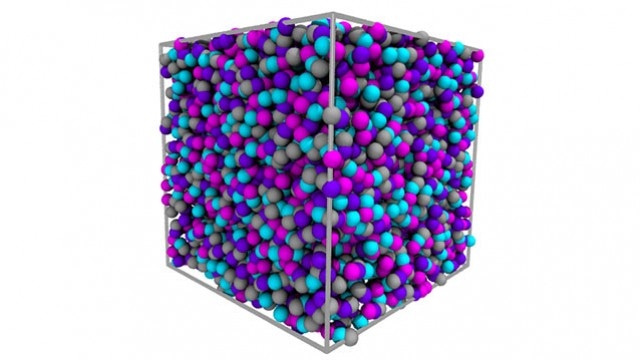May 2 2019
The characteristics of glass are not totally vivid. Specifically, the way its atoms are arranged and behave is shockingly opaque.
 Multiscale modeling of a polymer glass to predict its temperature-dependent properties. (Image credit: Wenjie Xia)
Multiscale modeling of a polymer glass to predict its temperature-dependent properties. (Image credit: Wenjie Xia)
The issue is that glass is an amorphous solid, a group of materials that belongs to the cryptic domain between liquid and solid. Glassy materials also include polymers, or typically used plastics. While it might seem to be stable and static, the atoms of glass are continually shuffling in an exasperatingly pointless search for equilibrium. This shifty behavior has rendered the physics of glass virtually difficult for researchers to determine.
Currently, a multi-institutional research team including Northwestern University, North Dakota State University and the National Institute of Standards and Technology (NIST) has formulated an algorithm with the aim of giving polymeric glasses some more clarity. The algorithm makes it feasible for scientists to develop coarse-grained models to design materials with dynamic properties and estimate their recurrently varying behaviors. Known as the “energy renormalization algorithm,” it is the first to precisely predict glass’ mechanical behavior at various temperatures and could pave the way to fast discovery of new materials, engineered with ideal properties.
“The current process of materials discovery can take decades,” said Northwestern’s Sinan Keten, who co-led the study. “Our approach scales molecular simulations up by roughly a thousand times, so we can design materials faster and examine their behavior.”
“Although glassy materials are all around us, scientists still struggle to understand their properties, such as their fluidity and diffusion as temperature or composition vary,” said Jack F. Douglas, a NIST research fellow, who co-led the research with Keten. “This lack of understanding is a serious limitation in the rational design of new materials.”
The research paper published recently in the journal Science Advances. Wenjie Xia, an assistant professor of civil and environmental engineering at North Dakota State University, was the first author of the paper.
Glass’ odd behavior comes from the way it is manufactured. It begins as a hot pool of molten material that is then quickly cooled. Although the end material wants to attain equilibrium in a cooled state, it is extremely vulnerable to varying temperatures. In case the material is heated, its mechanical properties can vary radically. This makes it hard for scientists to proficiently predict the mechanical properties by using current molecular simulation methods.
As simple as glass looks, it’s a very strange material. It is amorphous and doesn’t have an equilibrium structure, so it’s constantly evolving by slow movements of its molecules. And then there is a lot of variation in how it evolves depending on temperature and molecular features of each glassy material. These processes take a very long time to compute in molecular simulations. Speeding up computations is only possible if we can map the positions of the molecules to simpler structural models.
Sinan Keten, Associate Professor of Mechanical Engineering and Civil and Environmental Engineering, McCormick School of Engineering, Northwestern University.
Glass’ structure is in plain contrast to a crystalline solid, wherein atoms are set up in an ordered, symmetrical and predictable fashion. “It’s easy to map atoms in crystalline materials because they have a repeating structure,” Keten explained. “Whereas in an amorphous material, it is difficult to map the structure due to the lack of long-range order.”
“Because of the amorphous and disordered nature of glass, its properties could vary with temperature substantially, making the prediction of its physical behavior extremely difficult,” Xia added. “Now, we have found a new way to solve this problem.”
To look into this challenge, Keten, Douglas, Xia, and their partners came up with their algorithm to factor in a number of ways glass molecules would travel or not travel based on variable temperatures over time. To compute the position of each atom within glass would be extremely slow and tedious — even for a high-powered algorithm — to measure. So Keten and his partners used “coarse-grained modeling,” a streamlined method that studies clusters of atoms instead of single atoms. Their new methodology efficiently formulates limits for the interactions among these coarser particles so that the model can trap the exciting slow-down in molecular motion as the glassy material begins to cool.
“We cannot do an atom-by-atom simulation for even glass films of nanoscale thickness because even that would be too large,” Keten said. “That’s still millions of molecules. The coarse-grained models allow us to study larger systems comparable to experiments done in the lab.”
Thus far, Keten and his team have verified their algorithm against three already well-established and very diverse types of polymeric glass-forming liquids. In each scenario, the algorithm correctly predicts the identified dynamic properties spanning a wide range of temperatures.
Explaining the physics of glasses has famously been one of the biggest problems that scientists haven’t been able to solve. We’re getting closer to understanding their behavior and solving the mystery.
Sinan Keten, Associate Professor of Mechanical Engineering and Civil and Environmental Engineering, McCormick School of Engineering, Northwestern University.